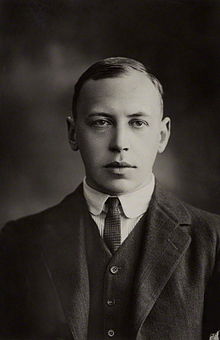Alfred Noyes
| Alfred Noyes CBE |
|
|---|---|

Portrait of Alfred Noyes, by Alexander Bassano, 1922
|
|
| Born |
16 September 1880 Wolverhampton, England |
| Died | 25 June 1958 (aged 77) Isle of Wight |
| Resting place | Freshwater, Isle of Wight |
| Occupation | Poet |
| Language | English |
| Nationality | English |
| Alma mater | Exeter College, Oxford |
| Period | 1902–1958 |
| Notable works | "The Highwayman" "The Barrel-Organ" |
| Notable awards |
D.Litt., Yale University, 1913 CBE, 1918 |
| Spouse | Garnett Daniels (1907–1926) Mary Angela Mayne (1927–1958) |
| Children | Hugh Veronica Margaret |
|
|
|
Alfred Noyes CBE (16 September 1880 – 25 June 1958) was an English poet, short-story writer and playwright, best known for his ballads, "The Highwayman" and "The Barrel-Organ".
Noyes was born in Wolverhampton, England, the son of Alfred and Amelia Adams Noyes. When he was four, the family moved to Aberystwyth, Wales, where his father taught Latin and Greek. The Welsh coast and mountains were an inspiration to Noyes. In 1898, he left Aberystwyth for Exeter College, Oxford, where he distinguished himself at rowing, but failed to get his degree because, on a crucial day of his finals in 1903, he was meeting his publisher to arrange publication of his first volume of poems, The Loom of Years (1902).
From 1903 to 1913, Noyes published five additional volumes of poetry, among them The Flower of Old Japan (1903) and Poems (1904), which included one of his most popular poems, "The Barrel-Organ". His most famous poem, "The Highwayman", was first published in the August 1906 issue of Blackwood's Magazine, and included the following year in Forty Singing Seamen and Other Poems. In a nationwide poll conducted by the BBC in 1995 to find Britain's favourite poem, "The Highwayman" was voted the nation's 15th favourite poem.
Noyes' major work in this phase of his career was Drake, a 200-page epic in blank verse about the Elizabethan naval commander Sir Francis Drake, which was published in two volumes (1906 and 1908). Both in style and subject, the poem shows the clear influence of Romantic poets such as Tennyson and Wordsworth. Noyes' only full-length play, Sherwood, was published in 1911; it was reissued in 1926, with alterations, as Robin Hood. One of his most popular poems, "A Song of Sherwood", also dates from 1911. He published in
In 1907, Noyes married Garnett Daniels, youngest daughter of US Army Colonel Byron G. Daniels, a Civil War veteran who was for some years U.S. Consul at Hull. Noyes first visited America in February 1913, partly to lecture on world peace and disarmament and partly to satisfy his wife's desire that he should gather fresh experiences in her homeland. His first lecture tour lasted six weeks, extending as far west as Chicago. It proved so successful that he decided to make a second trip to the US in October and to stay six months. In this trip, he visited the principal American universities, including Princeton, where the impression he made on the faculty and undergraduates was so favourable that in February 1914 he was asked to join the staff as a visiting professor, lecturing on modern English literature from February to June. He accepted, and for the next nine years he and his wife divided their year between England and the US. At Princeton, Noyes' students included F. Scott Fitzgerald, Edmund Wilson and John Peale Bishop. He resigned his professorship in 1923, but continued to travel and lecture throughout the United States for the rest of his life. His wife died in 1926 at Saint-Jean-de-Luz, France, where she and Noyes were staying with friends.
...
Wikipedia
